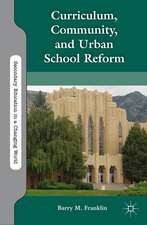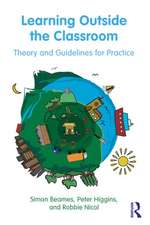Quadrilingual Education in Singapore: Pedagogical Innovation in Language Education: Education Innovation Series
Editat de Rita Elaine Silver, Wendy D. Bokhorst-Hengen Limba Engleză Hardback – 21 ian 2016
Din seria Education Innovation Series
- 24%
 Preț: 742.69 lei
Preț: 742.69 lei - 18%
 Preț: 732.70 lei
Preț: 732.70 lei - 15%
 Preț: 647.08 lei
Preț: 647.08 lei - 15%
 Preț: 644.63 lei
Preț: 644.63 lei - 15%
 Preț: 648.89 lei
Preț: 648.89 lei - 15%
 Preț: 656.58 lei
Preț: 656.58 lei - 15%
 Preț: 648.56 lei
Preț: 648.56 lei - 18%
 Preț: 946.69 lei
Preț: 946.69 lei - 15%
 Preț: 643.34 lei
Preț: 643.34 lei - 18%
 Preț: 900.18 lei
Preț: 900.18 lei - 20%
 Preț: 571.85 lei
Preț: 571.85 lei - 15%
 Preț: 641.03 lei
Preț: 641.03 lei - 18%
 Preț: 948.29 lei
Preț: 948.29 lei - 20%
 Preț: 564.21 lei
Preț: 564.21 lei - 15%
 Preț: 647.59 lei
Preț: 647.59 lei - 18%
 Preț: 1003.70 lei
Preț: 1003.70 lei - 18%
 Preț: 901.74 lei
Preț: 901.74 lei
Preț: 789.35 lei
Preț vechi: 962.62 lei
-18% Nou
Puncte Express: 1184
Preț estimativ în valută:
151.06€ • 157.13$ • 124.71£
151.06€ • 157.13$ • 124.71£
Carte tipărită la comandă
Livrare economică 15-29 aprilie
Preluare comenzi: 021 569.72.76
Specificații
ISBN-13: 9789812879653
ISBN-10: 981287965X
Pagini: 326
Ilustrații: XII, 326 p. 27 illus. in color.
Dimensiuni: 155 x 235 x 21 mm
Greutate: 0.65 kg
Ediția:1st ed. 2016
Editura: Springer Nature Singapore
Colecția Springer
Seria Education Innovation Series
Locul publicării:Singapore, Singapore
ISBN-10: 981287965X
Pagini: 326
Ilustrații: XII, 326 p. 27 illus. in color.
Dimensiuni: 155 x 235 x 21 mm
Greutate: 0.65 kg
Ediția:1st ed. 2016
Editura: Springer Nature Singapore
Colecția Springer
Seria Education Innovation Series
Locul publicării:Singapore, Singapore
Public țintă
ResearchCuprins
Introduction.- Chapter 1 Overarching themes, bilingual dreams and multilingual landscapes: Quadrilingual education in Singapore.- Section 1: Transitions.- Chapter 2 Transmission and development of literacy values and practices: An ethnographic study of a Malay family in Singapore.- Chapter 3 "I believe, therefore I practice": Teachers' beliefs on literacy acquisition and their classroom practices.- Chapter 4 Commentary on 'Transitions'.- Section 2: Competencies.- Chapter 5 A reading profile of Singapore primary school students and implications for reading pedagogy.- Chapter 6 Morphological awareness and reading development in bilingual English-Chinese children in Singapore.- Chapter 7 Taking stock of the effects of strategies-based instruction on writing in Chinese and English in Singapore primary classrooms.- Chapter 8 Commentary on 'Competencies'.- Section 3: Practices.- Chapter 9 Student engagement in reading.- Chapter 10 Distinctiveness and uniformity: Teaching language in Singapore primary grades 1 & 2.- Chapter 11 Cultural representation in Teachers' talk: A functional analysis of Singapore's Chinese classroom discourse.- Chapter 12 Morphological teaching and Singaporean children's English word learning.- Chapter 13 Commentary on 'Practices'.- Section 4: Reforms.- Chapter 14 Use and impact of spoken Tamil in the early Tamil classrooms.- Chapter 15 Inculcation of Malay values and culture in language pedagogy in Singapore.- Chapter 16 Coding and comparing pedagogic features of teaching practices: What happens in Chinese language classes in Singapore's primary school?.- Chapter 17 Teaching Chinese to English-speaking Bilinguals.- Chapter 18 Commentary on 'Reforms'.- Conclusion.- Chapter 19 Final words: A reflective synthesis.
Notă biografică
Rita Elaine Silver is an Associate Professor in English Language and Literature, National Institute of Education, Singapore. Her specialisation is language-in-education with an emphasis on policy-classroom pedagogy-professional development connections. Her work has appeared in Language Policy, TESOL Quarterly, System,Language Teaching Research, Language in Education, Cambridge Journal of Education, and Journal of Educational Change. Previous monographs includeLanguage in Education: Social Implications (with M. Lwin, 2014); Language Learning in New English Contexts (with L. Alsagoff & C. C. M. Goh, 2009) andLanguage Learning: Home, School and Society (with C. C. M. Goh, 2007). She is co-editor of Language and Education.
Wendy Bokhorst-Hengis an Associate Professor in Education at Crandall University, Moncton, New Brunswick, Canada. Prior to her current position, she has also held positions in Singapore at the National Institute of Education, in Washington, D.C. at American University, and has directed a language program at the British Council in Beijing, China. Her research involves a focus on language policy and ideology, English as an international language, multiculturalism and diversity, and comparative education. Her work has appeared in World Englishes, Multilingua, TESOL Quarterly, Journal of Current Issues in Language Planning. She has also contributed chapters to a number of books. She has a co-authored volume with S. McKay, International English in its Sociolinguistic Contexts.
Textul de pe ultima copertă
This book explores Singapore’s language education system. Unlike previous volumes, which discuss the bilingual requirement for learning, it focuses on Singapore’s quadrilingual system, bringing together articles on each of the four languages – English, Mandarin, Malay and Tamil – as well as articles that examine more than one language. It highlights past successes, current concerns, and future directions for language education. The book focuses on classroom pedagogy in all four official languages, showcasing how languages are taught and learned in Singapore as a basis for better understanding the system “from the inside out.” The authors present empirical, classroom-based studies on language pedagogy in all four languages, as well as updated information on the current socio-political context and how it has influenced attempts at pedagogical innovation. Consideration is given to the dialectical relationship between policy and practice. The chapters also include discussions of pre-school-age learning, influences of language policy, home literacy practices, and commentaries by international language-in-education scholars. This approach also provides a basis for international comparison – especially for those who are interested in fostering English proficiency while maintaining one or more national languages. The volume is particularly important in light of the continuing international efforts to integrate English into national educational systems where it is not the dominant language.
Caracteristici
Focuses on empirical classroom research on the four official languages, showcasing the overarching quadrilingual education system in Singapore Also brings in insights on early years / primary level language-in-education settings and issues Highlights past successes, current concerns and future directions for language education in Singapore Examines the dialectical relationship between policy and practice Provides in-depth knowledge on Singapore’s language education system that allows readers to understand the system as well as gain insights into their own educational systems, issues, concerns and pedagogies Provides a basis for international comparison – especially for those who are interested in fostering English proficiency while maintaining one or more national languages














